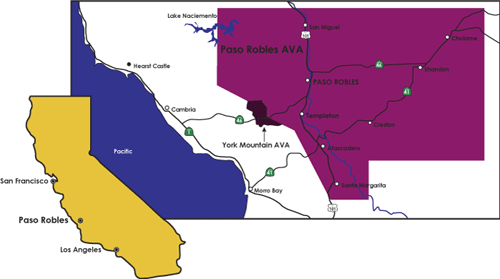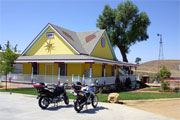In the summer of 2002, I embarked on a 3300 mile motorcycle tour of the California, Oregon, and Washington coasts, with strategic stops in the various wine regions along the way. The entire trek was amazing, but it was on this trip that I truly “discovered” the wines of Paso Robles.
At the time, I knew the area as a producer of big, jammy zinfandels. What I quickly learned, however, was that the region produces an amazingly diverse collection of wines in as many different styles as there are vintners. It turns out that the varied topography of the Paso Robles AVA not only makes for great motorcycle touring, it has a microclimate to suit virtually any varietal you want to grow. According to the Paso Robles Wine Country Alliance, over 40 varietals are currently in production!
Though often thought of as an “emerging” wine region, the first Paso Robles vineyards were planted in the late 1700s by the Franciscan missionaries and commercial winemaking in the region dates back to the founding of the Ascension winery in 1882, which is still operating today as York Mountain Winery. Up through the late 1960s, Zinfandel was by far the most widely-planted varietal and it retains a strong influence on the region’s wines, but it now accounts for less than 10% of the region’s 26,000 acres of vineyards.
The transformation began around 1970 with the large-scale planting of Cabernet, which remains the most widely-planted varietal. A virtual varietal explosion started in the 1980s with Arciero Vineyards’ introduction of premium Italian varietals and continued in the 1990s with Tablas Creek’s cultivation of Rhone varietals cloned directly from the famed Chateauneuf-du-Pape vineyards of Chateau de Beaucastel. Today, Paso’s leading wineries are as likely to be known for their Syrahs and Rhone blends as they are for their Zinfandels or Cabernets.
I didn’t do a lot of tasting that first trip to Paso Robles—wine tasting and motorcycling aren’t really compatible activities—but it was enough to convince me to pay more attention to Paso Robles wines. While I still have a soft-spot for the fruit-forward “Paso-style” zins that first led me to the region, the region’s best wines are more than just fruit bombs. Whether your palate leans toward minerally Rhone-style white wines, elegant cabernets, spicy Syrah blends, or full-bodied Italian varietals, Paso Robles has a lot to offer.
About the Region

Paso Robles is located on the central coast of California, mid-way between Los Angeles and San Francisco. Named for the picturesque oaks that dot the landscape, the city of Paso Robles sits at the heart of the Paso Robles AVA, about 20 miles from the coast. The Paso Robles AVA encompasses 24 square miles of varied terrain and is the third-largest AVA in California. Though the microclimates vary considerably, summers are warm and dry throughout the region. Even on the hottest days, however, temperatures tend to drop dramatically at night—as much as 50 degrees in the areas that experience the most coastal cooling.
A distinction is often made between “Eastside” and “Westside” Paso Robles. The Westside vineyards flank the coastal range and are characterized by rocky limestone hillsides and the temperature-moderating influence of the coastal air. The Eastside vineyards line the rolling hills on the east side of the Salinas river where the temperatures routinely run 5-10 degrees hotter. It’s all about location, however, as some Eastside vineyards benefit from the cooling effects of the Templeton gap “wind tunnel” and experience lower overall temperatures than many Westside vineyards, especially those further north toward Lake Naciemento.
A Few Favorites
 Tobin James
Tobin James
Tablas Creek—leading Paso producer of Rhone varietals. Well-balanced wines that tend to be slightly more fruit-forward than their Chateau de Beaucastel counterparts. Their white wines really shine.
Villa Creek Cellars—my current favorite for Syrah-based blends. Started as the house label for the Paso Robles restaurant of the same name. Production is quite limited, so the best way to try Villa Creek wine is usually to go to the restaurant, which is one of the best in Paso Robles.
Chateau Margene—a specialty producer of elegant, age-worthy cabernets. Located on the Eastside, but in a cooler microclimate perfect for ripening Cabernet without going over the top.
Nadeau Family Vintners—a family-run micro-winery that specializes in Zinfandels and Rhone varietals, but produced an absolutely fabulous Barbera in 2003 & 2004.






